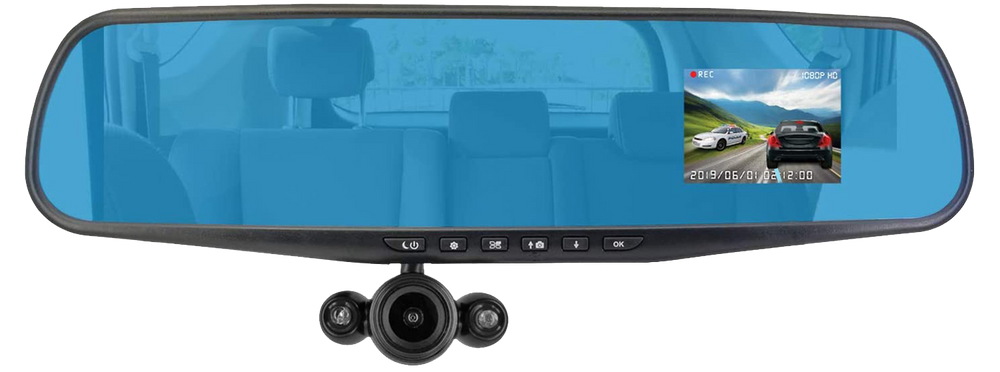Choosing between dash cam rear view mirror and rear view safety systems can be challenging with so many options available. Understanding the features, benefits, and limitations of both systems will help you make an informed decision. This article outlines key factors to consider, including safety, usability, cost, and installation.
Understanding Dash Cam Rear View Mirrors
Dash cam rear view mirrors combine traditional mirror functionality with advanced camera technology. These mirrors offer real-time video footage of the road, helping drivers capture crucial moments for safety or legal purposes. They can also serve as a backup camera, improving parking and reversing skills. Dash cam mirrors are typically easy to install and provide multiple functionalities in one device, making them a popular choice among drivers.
The Purpose of Rear View Safety Systems
Rear view safety systems primarily focus on improving visibility and preventing accidents while reversing. They include backup cameras, sensors, and sometimes parking assist technology. These systems are designed to alert drivers about obstacles or provide a clearer view of what’s behind them. Rear view safety systems offer peace of mind, especially in crowded parking lots or when reversing in tight spaces. Unlike dash cams, their primary purpose is to ensure safety rather than record footage.
Features of Dash Cam Rear View Mirrors
Dash cam rear view mirrors typically feature a high-definition camera that records both front and rear views. They often include a wide-angle lens to capture a broader range of the environment. Some models come with built-in GPS to track your location and speed, while others offer cloud storage options for footage. Additionally, many rear view mirrors come with a touch screen that allows drivers to easily access footage and settings. These mirrors also tend to have a sleek, modern design, blending seamlessly with your vehicle’s interior.
Features of Rear View Safety Systems
Rear view safety systems consist of cameras, sensors, and sometimes displays to assist drivers in parking and reversing. They usually include a wide-angle camera mounted on the rear of the vehicle, which provides a live feed to a screen on the dashboard or rearview mirror. In some systems, sensors can detect objects behind the vehicle and trigger audible warnings. Some advanced systems even offer parking assist technology, which helps steer the car into tight spaces, making parking easier and safer.
Installation Process for Dash Cam Rear View Mirrors
Installing a dash cam rear view mirror can be relatively straightforward. Many models are designed to replace the vehicle’s existing rearview mirror, so no additional mounting is required. The camera typically connects to the vehicle’s power supply via the fuse box or a cigarette lighter adapter. However, some models may require professional installation for advanced features, like GPS tracking or cloud storage. Always follow the manufacturer’s instructions to ensure proper installation and avoid damaging the vehicle’s electrical system.

Installation Process for Rear View Safety Systems
Rear view safety systems require installation of cameras and sensors, which may involve more steps than a dash cam rear view mirror. A rear camera needs to be mounted on the back of the vehicle, often near the license plate or on the bumper. Sensors must also be placed around the vehicle, particularly at the rear corners. The system’s wiring must connect to the vehicle’s electrical system, and the display screen is typically integrated into the dashboard or rearview mirror. Professional installation is often recommended for a clean and reliable setup.
Cost Comparison Between Dash Cam Rear View Mirrors and Safety Systems
When comparing costs, dash cam rear view mirrors tend to be more affordable than full rear view safety systems. Dash cam mirrors range in price based on their features, such as camera resolution, screen size, and additional functions like GPS or cloud storage. On the other hand, rear view safety systems can be more expensive due to the installation of multiple cameras and sensors, as well as the advanced technology in some models. Both options can be found at various price points, depending on the desired features.
Advantages of Dash Cam Rear View Mirrors
One of the biggest advantages of dash cam rear view mirrors is their ability to combine multiple functions into one device. Not only do they provide a traditional rearview mirror, but they also record video footage, improving overall safety. This is particularly helpful in case of accidents, as the footage can serve as evidence. Furthermore, many dash cam mirrors are easy to install, providing convenience without requiring significant changes to your vehicle. Additionally, the wide-angle camera offers better visibility while driving or parking, reducing blind spots.
Advantages of Rear View Safety Systems
Rear view safety systems are specifically designed to enhance driver visibility and prevent accidents while reversing. These systems are especially useful for individuals who frequently park in tight spaces or have difficulty seeing what’s behind them. The added safety features, such as parking sensors and obstacle detection, provide an extra layer of protection, alerting drivers to potential hazards. Some advanced systems even include parking assist features, which can automatically steer the vehicle into a parking spot, reducing the risk of collisions.
Considerations for Choosing the Right System
When choosing between a dash cam rear view mirror and a rear view safety system, consider your driving habits and priorities. If you frequently park in crowded areas or struggle with reversing, a rear view safety system with parking sensors and a backup camera may be more suitable. However, if you’re looking for a dual-purpose device that records footage for security and offers better visibility, a dash cam rear view mirror could be the better choice. Budget, ease of installation, and additional features are also important factors to keep in mind.
How to Maintain Both Systems
Both dash cam rear view mirrors and rear view safety systems require regular maintenance to ensure they continue to function properly. For dash cams, it’s important to clean the camera lenses periodically to avoid blurry footage. Additionally, checking the storage device for available space and formatting the memory card every few months will help maintain the system’s efficiency. For rear view safety systems, ensure that the cameras and sensors are clean and free from obstructions. Also, test the system regularly to ensure that all components are working correctly.
Conclusion
When deciding between dash cam rear view mirrors and rear view safety systems, it’s crucial to weigh your specific needs and budget. Dash cam mirrors provide a versatile solution, combining a rearview mirror and recording capabilities. In contrast, rear view safety systems offer dedicated safety features that enhance visibility and prevent accidents. Whatever your choice, both systems significantly improve driving safety. The Mirror Cam could be the perfect option for those seeking an integrated solution to both recording and safety needs.

